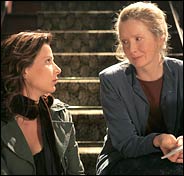And They All Died Happily Ever After, Sort Of
By VIRGINIA HEFFERNAN
Published: August 22, 2005
Some said the world would end in fire. Some said in ice.
But no one predicted that the finale to HBO’s apocalyptic drama “Six Feet Under” would be served room temperature. Instead, insiders, who had seen the show in advance, promised last week that the 75-minute episode would blow our minds. But, really, we should have been skeptical: our minds, after all, were already blown.

The magnificent and magnificently flawed series had compelled new, apprehensive attention with its July 24 episode, in which Nate Fisher (Peter Krause), the show’s main mensch – or was he a weasel? – collapsed after adulterous sex while coining, in the year’s best line of dialogue, an evocative contraction of the words “numb” and “arm”: narm.
Narm!
Then there was the July 31 episode, in which Nate seemed to recover, then spontaneously died – a reverse resurrection. The episode of Aug. 7, in which Nate’s family mourned his death, was as melancholy and philosophically rigorous an hour of drama as television has ever tried.
On Aug. 14, the family, six weeks after Nate’s death, spun into howling madness. Claire (Lauren Ambrose), Nate’s sister, freaked out about the war in Iraq, then crashed her car. David (Michael C. Hall), Nate’s brother, raved while endangering his children. And Brenda (Rachel Griffiths), Nate’s widow, dreamed of having sex with her unhinged brother.
Then she went into labor.

In last night’s episode, Brenda gave birth to Nate’s daughter: a small, soundless girl who seemed unwell. David left his family. Ruth (Frances Conroy), Nate’s mother, who had to give up her other granddaughter, Maya (Brenna Tosh and Bronwyn Tosh), despaired. Only Claire seemed to have reason to hope: she had an offer of a job in New York. The possibility that at least one of the benighted Fishers might escape their Los Angeles death trap was heartening.
Miraculously, things started looking up all around. Brenda’s daughter thrived. David reconnected with his boyfriend and their sons; they cut ties with the Fishers’ brisk, ambitious business partner, Rico (Freddy Rodriguez), and redid the funeral home in burgundy and stainless steel. Ruth, who spent much of the episode in a stupor, found her strength at last.
Finally, the whole crazy family sat down to dinner, at which they told stories about Nate and eventually toasted the absent son. There was laughter. Maya, Nate’s usually taciturn older daughter, who was back in Brenda’s custody, even managed to muster, “To Daddy!”
(Sidebar question: are the twin actresses playing Maya, who was featured in so many macabre scenes, traumatized yet?)

Suddenly, “Six Feet Under” seemed prepared to end on a note of uplift, hugs and Polonian advice: life goes on; family is where you find it; follow your dreams; to thine own self be true.
And it didn’t exactly not end that way, except that this show had one last mortal-coil shuffle to perform. This one was intended to be a showstopper.
As Claire drove east in a new car – bless her, she had totaled that hideous hearse in her accident – she let her mind wander. Into the young, agile mind came a premonition: everyone would die. Suddenly the show became a montage of the ways all the show’s remaining major characters would leave this world. Keith (Mathew St. Patrick), David’s boyfriend, was shot in the back of an armored truck. An aged Brenda died while listening to her brother ramble on about emotional closure. Ruth expired in bed, attended by David and her companion, George (James Cromwell). David keeled over while fantasizing about Keith. Rico collapsed on a cruise ship.
And finally Claire herself, her eyes so rheumy they looked opaque, died in a huge dark-wood bed, surrounded by evidence of a well-lived, love-filled life and an HBO set designer’s sense of future décor. The year was 2085. She was 102.
The sequence flew by. It was very pale. The aging makeup, unfortunately, turned all of them into characters from “Cocoon” or Miss Havisham, with spectral expressions and white flyaway hair. Keith’s murder seemed stupid. In fact, the whole overwrought montage was at least half ludicrous, and almost half lovely.

But that precious ratio – which recalls the balance of silliness and beauty in Trollope and some of Hardy – has always been the show’s strong suit, a 19th-century tone ingeniously invented and confidently maintained over five seasons. It’s rare that a sensibility remains so unified and so unshy on a fancy soap opera; melodramatists too often get scared of being called hysterics and betray their genre, blowing it off for dumb stunts or trying, in some 11th hour, to sober up and turn manly. But the producers of “Six Feet Under” never cared about impressing the “Wire” or “Deadwood” audiences. They had their ratio, and they saw it through. “Six Feet Under” was a beautiful series, and its finale will suffice.
